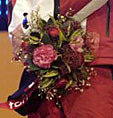 To most people watching the Olympic Games, the bouquet of flowers that the medalists receive is of little interest. To me, they are one of the most interesting aspects of the games perhaps sort of like the dresses celebrities wear at the Golden Globes or Academy Awards. A lot of planning and work goes into the bouquets and sometimes controversy about them even rears its head. The florist who wins the bid for the bouquets from the Olympic Committee has many criteria to meet and many factors to consider when designing the bouquet, one of which is the Committee’s desire to have the bouquet represent the region where the Games are being held. Other factors such as flower availability, durability, and cost also figure into the design but all of the bouquets should be a reflection of the culture that produced it to some extent.
To most people watching the Olympic Games, the bouquet of flowers that the medalists receive is of little interest. To me, they are one of the most interesting aspects of the games perhaps sort of like the dresses celebrities wear at the Golden Globes or Academy Awards. A lot of planning and work goes into the bouquets and sometimes controversy about them even rears its head. The florist who wins the bid for the bouquets from the Olympic Committee has many criteria to meet and many factors to consider when designing the bouquet, one of which is the Committee’s desire to have the bouquet represent the region where the Games are being held. Other factors such as flower availability, durability, and cost also figure into the design but all of the bouquets should be a reflection of the culture that produced it to some extent.
Let’s explore this idea by matching up the bouquets presented at 14 Games with the area that produced them. In addition to a picture of each bouquet, information is provided on the floral material as available. The answers can be found at the end of the post. When you finish trying to match the bouquets to the city and region that produced it ask yourself if the bouquets have met the Committee’s goal of having a distinct regional look?
The cities to match bouquets to are:
Albertville, France
Athens,Greece
Atlanta, United States
Barcelona, Spain
Beijing, China
Calgary, Canada
Lillehammer, Norway
Los Angeles, United States
Nagano, Japan
Salt Lake City, United States
Sarajevo, Yugoslavia
Seoul, South Korea
Sidney, Australia
Turin, Italy
| PAST OLYMPIC BOUQUETS | |
|---|---|
| Bouquets | Description of flowers in the bouquet (Can you identify the city that presented each bouquet?) |
 |
1. Summer 2008 Nine Red Roses (nine is a lucky number and roses stand for hospitality of the people hosting the games), Six hypericums, six Physostegia virginiania, six plantain lily (Hosta) and six Ophiopogon japonicus (the number six is lucky and represents smoothness). |
 |
2. Winter 2006 Azaleas, Camellias (pink, white and red), Rhodendrons, and greenery. The green, red and white colors matched the country’s flag. |
 |
3. Summer 2004 Blue amaranths, orange gerberas, red roses, yellow solidaster, yellow chrysanthemums and olive tree leaves. |
 |
4. Winter 2002 Long stemmed roses. |
 |
5. Summer 2000 Waratah, Kangaroo Paw, flannel flower, eucalyptus, wax flower, Billy buttons and three varieties of Grevillia. |
 |
6. Winter 1998 Mixed bouquet that infuriated the Dutch who had developed special tulips for the occasion. |
 |
7. Summer 1996: sunflower, lilies, and delphinium (royal blue). |
 |
8. Winter 1994 Yellow and white Tulips. |
 |
9. Summer 1992 Lamonium and mini carnations. |
 |
10. Winter 1992 Red gerbers, white daisy mums |
 |
11. Summer 1988 Pink gladiolus and white daisy mums |
 |
12. Winter 1988 Red roses and white Calla Lilies (?) |
 |
13. Summer 1984 Birds of Paradise, red gerbers. |
 |
14. Winter 1984 Large mixed bouquet |
Extra credit: What future Olympic city is considering presenting potted plants wrapped in natural materials to the metal winners…London, England; Sochi, Russia; or Rio de Janeiro, Brazil?
Answers:
2008 – Beijing
2006 – Turin
2004 – Athens
2002 – Salt Lake City
2000 – Sidney
1998 – Nagano
1996 – Atlanta
1994 – Lillehammer
1992 – Barcelona (Summer) Albertville (Winter)
1988 – Seoul (summer) Calgary (Winter)
1984 – Los Angeles (Summer) Sarajevo (Winter)
Extra credit – London.

[…] If you would like to learn more about Olympic bouquets see my post on Olympic Bouquets of the Past. […]